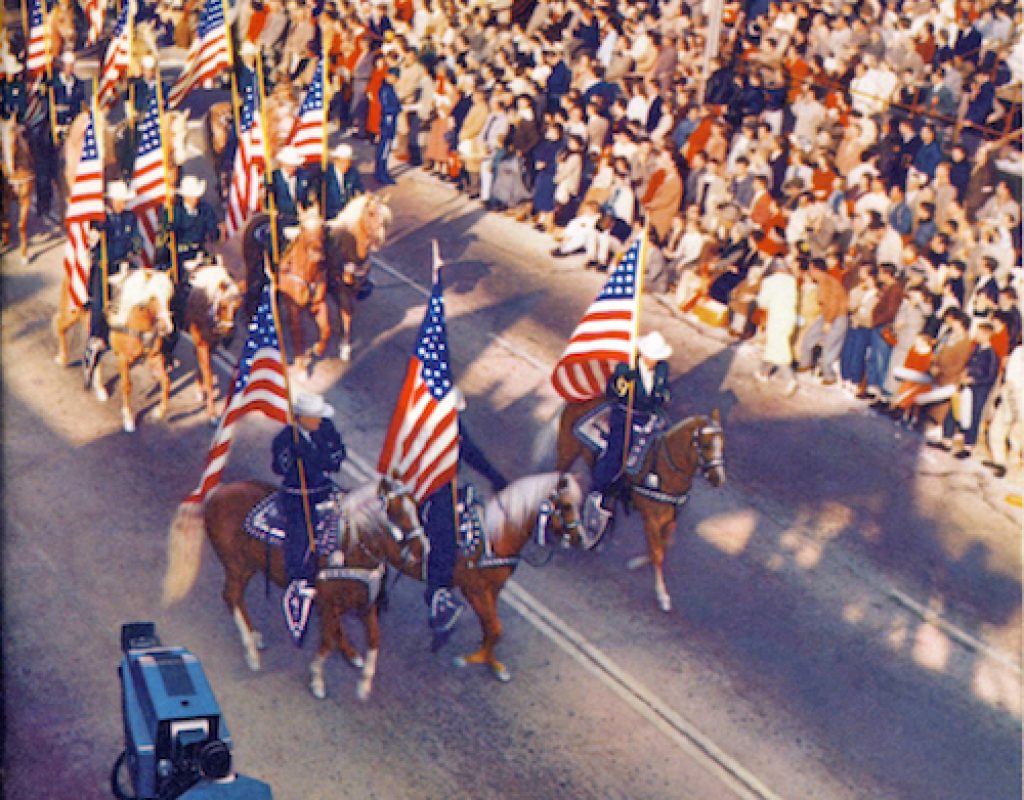January 1, 2019, marks the 130th Tournament of Roses Parade in the California city of Pasadena. Meanwhile, the Eastern and Midwest portions of North America shiver from cold and snow. Over the years a tradition developed. Those who could make the trip to Southern California would arrive to a warm, sunny climate. Californians encouraged this influx of snow weary residents from other parts of the country and the world. In 1890, the members of Pasadena’s Valley Hunt Club started dressing up their buggies with some of the brilliantly colored flowers that grew in their gardens all year round.
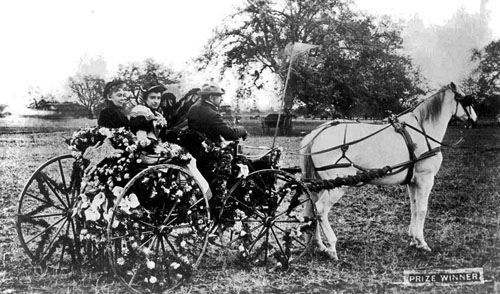
“In New York, people are buried in snow,” announced Professor Charles F. Holder at a Club meeting, “Here our flowers are blooming and our oranges are about to bear. Let’s hold a festival to tell the world about our paradise.”
In 1925, the first wire photo pictures were transmitted and readers could see the pictures in the same week as they were taken. The New Year’s Day tradition had been born.
It took a while longer to get the American football game underway. The early “tournaments” were about jousting, foot races, polo, tug-of-war and chariot races. But American football eventually made its way into the celebration after taking several years to change from chariot racing. In 1916, the tournament became the annual football contest between the best of the Pacific Eight and the Big Ten football conferences. It was played in Tournament Park, the site of the chariot races. Eventually it became the ultimate site of the Rose Bowl. It also helped the tourist trade that Hollywood was a just few miles just down the road, too!
Interest in the parade lingered on the newspaper pages and in the theatrical newsreels. The football game should have garnered more excitement but it did little to overshadow the parade event. But newspapers nor the newsreels could do it justice. Even with Warner Brothers/Pathe exhibiting a special color newsreel, only a few select highlights could be shown. Those putting up with snow and ice in the Midwest and the east could only imagine what experiencing the parade would be and the event continued to capture the world’s attention.
Then on New Year’s Day, 1940, television made its first appearance via Don Lee’s experimental television station W6XAO (the station’s experimental call letters assignment) lead by engineer Harry Lubcke. In 1930, Don Lee (who already had established a network of radio stations) wanted to develop a television station in Los Angeles. He hired Lubcke to be his Director of Television and Lubcke quietly started making major strides it bringing television out of the laboratory and into the home.
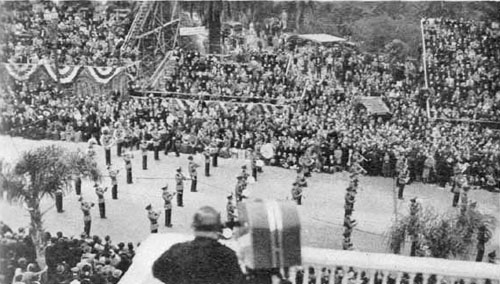
Ed Reitan was an electronics engineer with a keen interest in television. In comments he made to the Early Television Foundation he stated, “The telecast was on a rare rainy day so the iconoscopes would have had sensitivity problems.” But acknowledgement of the pick-up came from owners of some of the few receivers in the area. In his article for the SMPE (The “T” for television in SMPTE had not yet been added), Lubcke observed “At home [TV] receivers seven miles from W6XAO it was possible to see the wet streets at certain camera angles before the announcer admitted it was raining.”
Incidentally, Reitan collected old television receivers and owned an RCA RR-359-B mirror lid model gifted it to him by a gentleman in Los Angeles who told him it was this TV he used to get his neighbors to come in on a rainy New Year’s day and experience the Rose Parade for the first time on television. So television ownership was already making homes popular!
For the parade that year, two RCA 500-A iconoscope cameras were setup on the Elk’s lodge roof overlooking Colorado Boulevard. They were equipped with 6.5 inch lens for wide shots and a 19 inch lens for close-ups. A master control position was set up inside the top floor of club. The picture in the SMPE article, it looks like an attic space. Lubcke adds, “The equipment was manufactured by the Radio Corporation of America and was the first set of the “suitcase” type that was constructed.”
Don Lee Broadcasting was affiliated with the nationwide Mutual Radio network who was going to cover the parade for radio listeners. W6XAO would have use of their feed. However, Lubcke’s article tells us, “There existed a dual problem in synchronizing the camera operations with word description of the event and the proper aural presentation for a nationwide audience.” The network announcers described the parade as they saw it. “It was necessary to have their description of a particular float end as the float reached the limit of the camera panning range.”
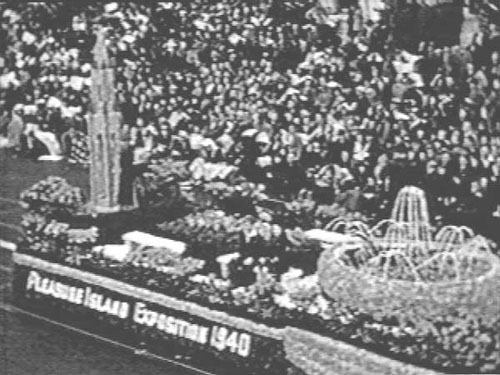
After the parade, W6XAO packed up their gear and left the Rose Parade. Lubcke was very busy moving their facility from the Don Lee Cadillac dealership to their new studio site atop Mount Lee above the Hollywood sign. And of course World War II brought many television operations to a halt.
Post WWII, W6XYZ was the first to commit to covering the parade as a yearly event. In 1947, KTLA’s commercial license would not be active until January 22nd but General Manager Klaus Landsberg, noted for doing live remote broadcasts of many city events, wanted to get the parade on the air. The station had received new Image Orthicon cameras and they were sent out with the remote unit. Pictures provided from the new cameras would be finer and sharper then the capabilities of the Iconoscope pickup tubes.
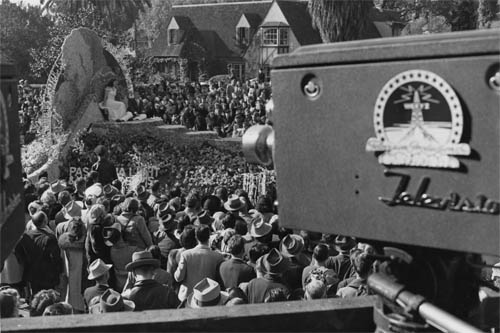
From the beginning, the Rose Parade has been open to anyone who wants to cover it. Any of the local stations or their networks could take advantage of the entertainment being provided on the streets of Pasadena with no licensing fee.
And they did. According to the Los Angeles Times, beginning in January 1st, 1948, the year after W6XYZ/KTLA covered the parade, W6XAO returned. Later, they would be licensed as KTSL and later become KNXT and KCBS. Later in 1948, two more Los Angeles stations signed on the air. KFI-TV (Later KHJ-TV/KCAL-TV) and KLAC-TV (Later KCOP) covered the parade the following New Year’s Day, 1949. A third station was also added to that line up. Coverage of the 1949 Rose Parade was the very first program KTTV aired.
In 1950, one more station was added. KNBH (Later KRCA/KNBC) signed on January 16th, 1949, too late to cover the 1949 parade. In 1950 the NBC Owned and Operated (O&O) station came to Pasadena but only covered the event for the local Los Angeles market. And finally, KECA-TV (Later KABC-TV) would sign on and eventually cover the parade starting in 1951.
In that short time, all seven of the Los Angeles VHF stations either were producing or had produced live coverage of the Rose Parade. By 1961, there had been almost ten years when all of Los Angeles television stations were carrying the parade at the same time. There was nothing else on television in Los Angeles. And they were using separate facilities to do so. As a Los Angeles Times writer wrote “It will be impossible to get anything else on television other than the Pasadena Tournament of Roses Parade this morning.”
As microwave links became available, KNBH teamed up with KFMB in San Diego and KRON in San Francisco. At the 1951 event, KNBH transmitted the festivities live to both cities in the “first three-city hookup via microwave of a Rose Parade telecast.” But for the most part, this was like keeping it all in the family. The live signal could not yet travel beyond the Rocky Mountains. And as long as local advertisers were willing to foot the bill, the stations were happy to accommodate. However, the following year, all that changed.
In September of 1951, President Truman was seen live in the east as he spoke from San Francisco during the Japanese Peace Talks. AT&T had at last completed the transcontinental circuits (a combination of microwave and coaxial cable) and made live television available coast to coast. On the first day of 1952, the NBC network made the Rose Parade a nationwide program for the first time. Viewers across the nation watched enviously as floats covered with live flowers passed through sunny days.
The stations had to settle for black and white facilities as the color standard had yet to be established. Finally, in December of 1953, the Federal Communications Commission approved the RCA color method making it compatible with black and white televisions already installed in homes. Expecting a decision from the FCC at any time, NBC had already scheduled “experimental” tests of the system. The network had scheduled three programs (“Amahl and the Night Visitors,” on December 20th, “Season’s Greetings,” December 22nd and a holiday oriented “Dragnet,” December 24th). These were run from its New York headquarters.
NBC also dispatched two remote trucks to be driven to Pasadena in time to make the color remote pickup.
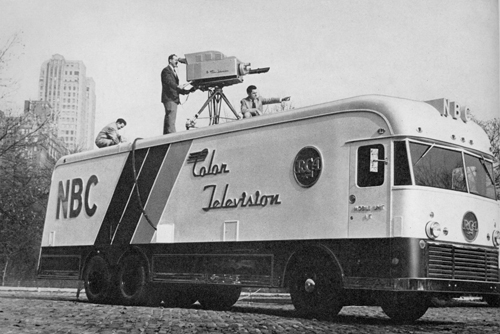
When the decision came, the FCC scheduled an “effective date for commercial compatible TV January 22nd,” but allowed that stations could begin airing shows without prior authority the day after the decision. AT&T had assured NBC the transcontinental line from west to east would be color ready by then but would not cover all the affiliates. About twenty-one cities would have access to the upgraded line that would allow them to carry the program in color.
All of this was for a non-existent color television supply that wouldn’t be available until about the middle of the year! But the public wanted to see it and the word (and the pictures) were getting out. There were many locations around the country that made it possible for the average consumer to see color television. From hotel ballrooms to furniture storefronts to newspaper lobbies, first-off-the-line color receivers were set up so the public would be able to view the live event.
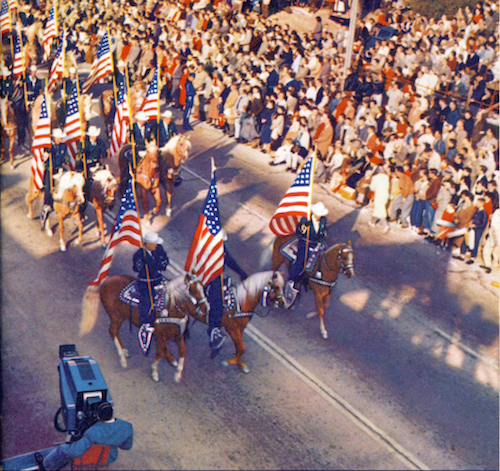
Ed Reitan remembered his first color experience well. He was a youngster who, with his family, had gone to the Hotel Paxton through a “cold and overcast day in Omaha that did look black and white.” He described the moment he laid eyes on the TV screen, “it was color and it was gorgeous! – rich Technicolor reds, greens, and blues, from the Tournament of Rose Parade in sunny and bright Pasadena, California.”
Amazingly, NBC didn’t deliver color from the parade in 1955. As Broadcasting magazine reported, “NBC said in November that it was unable to ship a color remote unit to Hollywood from Brooklyn in time to re-assemble and test it properly before the events.” The year instead belonged to KTLA.
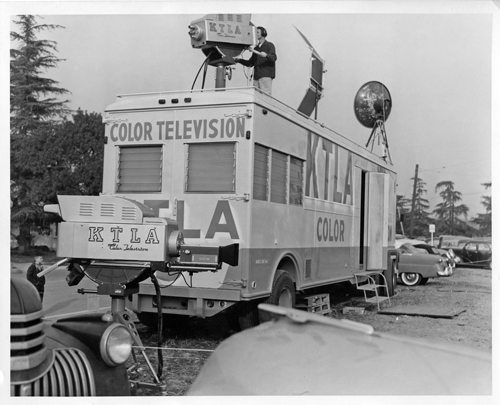
In a world without videotape what do you do for the viewers who get up late? You show the program over again using a different crew and facilities! Given the growth of the parade’s length some stations were airing the parade from different vantage points. The first production would take place a few minutes after the parade procession began. They would carefully time it so as one program ended the second would begin. The second coverage would commence toward the end of the parade route as the first units came into camera view. The stations carrying a second airing were still using black and white equipment. But Klaus Landsberg had ordered two RCA TK-40 color cameras early on. When they arrived, he outfitted a trailer for color coverage and stationed it near the parade’s finish line. The first coverage remained in black and white. KTLA used the same announcing team getting them to the second site with a police escort where they would add color to the later show and provide presumably higher audience numbers.
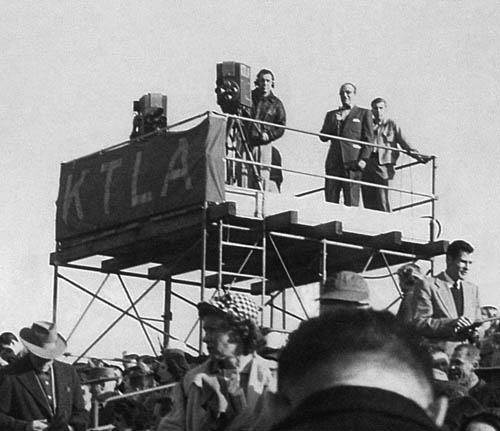
KTTV covered the Rose Bowl football contest the same way it had covered the Rose Parade – the first day of programing, but with a different set of announcers. They began doing repeats of the parade when the NBC network took over covering the football game on the same day it made the Rose Parade a nationwide experience. It was 1952 and was the year of the first coast-to-coast television broadcast of a football game. It should be noted that KTLA was first covering the a Rose Parade football game in 1948 and was bumped by KTTV the following year.
KECA also did an early and a late feed. In their case, they sold the live event to two different sponsors (they also had two different teams announcing it).
In addition to KTLA carrying the festivities in Los Angeles, they provided several feeds to other outlets. In 2014, John Moczulski , KTLA’s Vice President and station manager, told Kevin Downey of Radio/TVNewscheck “We also distribute our production to other Tribune and non-Tribune stations. Our production is also distributed to more than 200 countries around the world.” One group receiving the KTLA signal is the American Forces Radio & Television Service (AFRTS) operating around worldwide.
KTLA was also the first station to introduce stereo audio to its coverage in 1984. Now with HD, they have evolved it to a 5.1 friendly sound system.
KTTV went on to cover the Rose Parade until 1995 under several owners, Fox Broadcasting Company being the latest. In 1989, KTTV produced a version of the Rose Parade in 3-D with glasses provided by Coca-Cola company in Los Angeles, San Diego and Washington,D.C. The video was un-altered in other markets and glasses access was the key to watching the 3-D presentation.
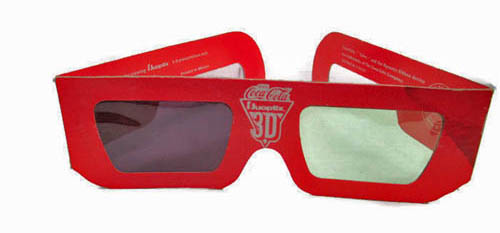
Univision began to provide its own coverage in 1963. Up until then, Spanish language radio stations were coordinating with KNBH/KRCA/KNBC, KTLA or KTTV for feeds and inviting listeners to tune in to their radio broadcasts for the commentary. KMEX-TV is the local Univision affiliate in Los Angeles and produces the telecast.
In 1996, the first cable network joined the parade coverage. The Home & Garden Television’s (HGTV) first live broadcast was provided commercial free. The network repeats the broadcast several more times after the initial live airing.
The changing face of television was reflected on January 1st, 1999 in the first High Definition coverage of the parade. It was KTLA who broke new ground by using Sony high definition equipment on board a production truck labeled HD-2 from National Mobile Television.
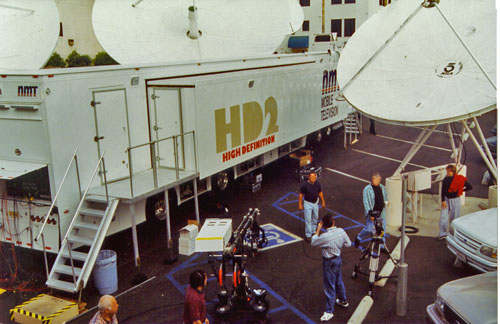
Latest addition is Skylink, a Chinese channel based in San Francisco and Los Angeles. Their live broadcast is in Mandarin and Cantonese languages. They joined the broadcast group in 2014.
Something struck a nerve back in 1890’s Pasadena that has resonated down over 130 years and doesn’t show any sign of letting up. The Rose Parade continues to evolve from its humble beginnings of dressing up horses and buggies. And television has been there from its own beginning and grown with it. The two are attached so firmly that they tower over any other event during the year. When I’m asked will television be around in the future, I have to answer “Yes! As long as we have New Year’s Day we will need some way to watch the Rose Parade!”

Filmtools
Filmmakers go-to destination for pre-production, production & post production equipment!
Shop Now